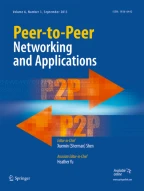Abstract
The computational grid is rapidly evolving into a service-oriented computing infrastructure that facilitates resource sharing for solving large-scale data and computationally intensive problems. Peer-to-peer (P2P) systems have emerged as an infrastructure enabling technologies for enhanced scalability and reliability in file sharing and content distribution. It is envisioned that P2P enabled service-oriented grid systems would virtualize various resources as services with high scalability and reliability. Many legacy software resources exist nowadays, but making them grid aware services for effective resource sharing has become an issue of vital importance. This paper presents GSLab, a toolkit for automatically wrapping legacy software into services that can be published, discovered and reused in grid environments. GSLab employs Sun Grid Engine (SGE) to enhance its performance in execution of wrapped services. Using GSLab, we have automatically wrapped a legacy computer animation rendering code written in C as a service that can be discovered and accessed in a SGE environment. The evaluation results show that the performance of GSLab improves with an increase in the number of computing nodes involved.
Similar content being viewed by others
References
Curbera F, Duftler M, Khalaf R, Nagy W, Mukhi N, Weerawarana S (2002) Unraveling the web services: an introduction to SOAP, WSDL, and UDDI. IEEE Internet Computing 6(2):86–93
Atkinson MP, De Roure D, Dunlop AN, Fox G, Henderson P, Hey AJG, Paton NW, Newhouse S, Parastatidis S, Trefethen AE, Watson P, Webber J (2005) Web service grids: an evolutionary approach. Concurrency and Computation: Practice & Experience 17(2–4):377–389
Foster I, Kesselman C, Nick JM, Tuecke S (2002) Grid services for distributed system integration. Computer 35(6):37–46
Czajkowski K, Ferguson DF, Foster I, Frey J, Graham S, Sedukhin I, Snelling D, Tuecke S, Vambenepe W (2005) The WS-resource framework. Available at http://www.globus.org/wsrf/specs/ws-wsrf.pdf. Accessed March 2008
Stoica I, Morris R, Liben-Nowell D, Karger D, Kaashoek M, Dabek F, Balakrishnan H (2003) Chord: a scalable peer-to-peer lookup protocol for internet applications. IEEE/ACM Trans Netw 11(1):17–32
Rowstron A, Druschel P (2001) Pastry: scalable, distributed object location and routing for large-scale peer-to-peer systems. In: Proceedings of the IFIP/ACM Int’l Conference on Distributed Systems Platforms (Middleware), November, pp 329–350
Ratnasamy S, Francis P, Handley M, Karp R, Shenker S (2001) A scalable content-addressable network. In: Proceedings of the 2001 Conference on Applications, Technologies, Architectures, and Protocols for Computer Communications, SIGCOMM, San Diego, CA, pp 161–172
Banerjee S, Basu S, Garg S, Garg S, Lee SJ, Mullan P, Sharma P (2005) Scalable grid service discovery based on UDDI. In: Proceedings of the 3rd International Workshop on Middleware for Grid Computing, pp 1–6
Qi M, Willis P (2003) Quasi3D Cel based animation. In: Proceedings of Vision, Video and Graphics 2003 (VVG03), Bath, UK, July
Li M et al (2003) Engineering high performance legacy codes as CORBA components for problem solving environments. J Parallel Distrib Comput 63(11):1152–1163 Nov
Li M, Qi M (2004) Leveraging legacy codes to distributed problem solving environments: a web services approach. Softw Pract Exp 34(13):1297–1309 Nov
Beazley D, Lomdahl P (1996) Lightweight computational steering of very large scale molecular dynamics simulations. In: Proceedings of the IEEE/ACM SuperComputing’96, Pittsburgh, USA, November
Huang Y, Taylor I, Walker D, Davies R (2003) Wrapping legacy codes for grid-based applications. In: Proceedings of the 17th International Parallel and Distributed Processing Symposium (IPDPS 2003), Nice, France, April
Taylor I, Shields M, Wang I, Harrison A (2005) Visual grid workflow in triana. Journal of Grid Computing 3(3–4):153–169
Oppenheimer D, Albrecht J, Patterson D, Vahdatm A (2004) Distributed resource discovery on planetlab with SWORD. In: Proceedings of the 1st Workshop on Real, Large Distributed Systems (WORLDS)
Cai M, Frank M, Chen J, Szekely P (2004) MAAN: A multi-attribute addressable network for grid information services. Journal of Grid Computing 2(1):3–14
Bharambe A, Agrawal M, Seshan S (2004) Mercury: supporting scalable multi-attribute range queries. In: SIGCOMM, 30 August–3 September, Portland, OR, USA, pp 353–366
Author information
Authors and Affiliations
Corresponding author
Rights and permissions
About this article
Cite this article
Li, M., Yu, B., Qi, M. et al. Automatically wrapping legacy software into services: A grid case study. Peer-to-Peer Netw. Appl. 1, 139–147 (2008). https://doi.org/10.1007/s12083-008-0011-9
Received:
Accepted:
Published:
Issue Date:
DOI: https://doi.org/10.1007/s12083-008-0011-9
